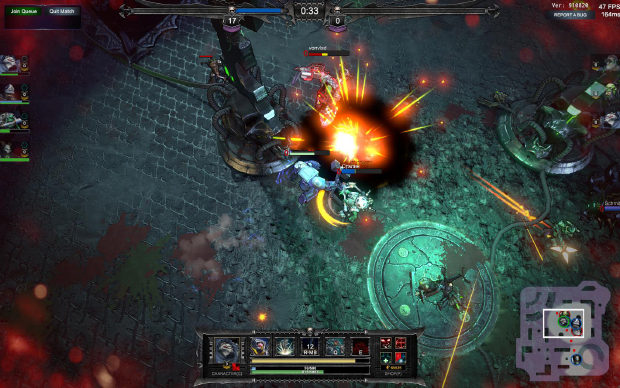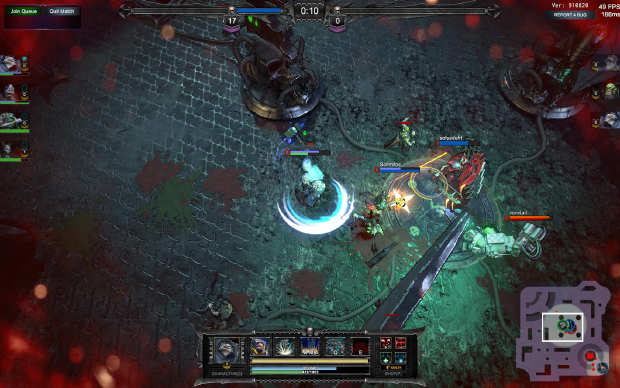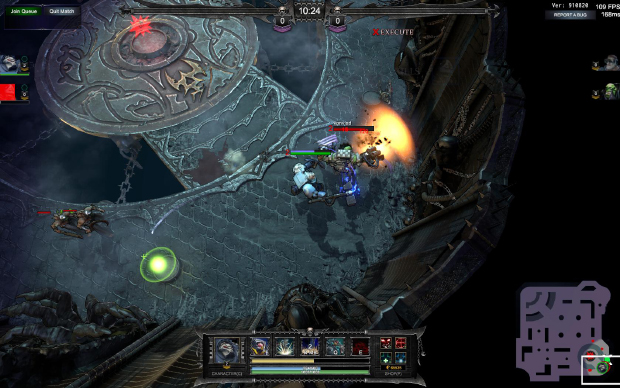Premature Evaluation: Dark Nexus Arena
MOBA, mo' problems
Each week Marsh Davies dons his power armour and plunges into the grimdarkness which is Early Access, coming back with any stories he can find and/or succumbing to the nightmarish seductions of the Warp. This week he’s been conscripted into F2P gladiatorial combat in Warhammer 40,000: Dark Nexus Arena, an action-oriented pseudo-MOBA moshpit.
I say “pseudo-MOBA” because, while the acronym is accurate in the most literal sense, Dark Nexus Arena currently lacks many of the things that have become the unspoken hallmarks of the genre - like lanes, towers, mercenary mobs and AI minions locked in a bloody equilibrium. In its barebones state, two teams of players pick from a multiracial handful of “veterans” (the heroic synonym barrel is not yet empty, it seems) and pile into each other repeatedly on a floating grey platform as part of some distant future bloodsport.
Murder an enemy player and you gain their soul. Stand in the circle at the centre of the map for an indeterminate amount of time and you bank that soul. Die and you lose whatever souls you’ve got on your person - the terse tutorial says your killer receives them, but this doesn’t always seem to happen. The team to hit 50 souls first wins - again according to the tutorial, but in practice it seems this number is 20.
The result of this is Inchoate Teamfights: The Game, and without the strategic complexities or escalation provided by territorial conquest, each bout feels rather shapeless and lacking in variety. In the more coordinated matches (and the current player population is not large enough to guarantee many of these) there are some incentives generated by the environment which threaten to give direction to the flow of battle: power-ups periodically spawn in the four corners of the map, while the soul-slurping circle is in the centre. Dominate the corners and your team will be better equipped to take the centre-ground - but in practice this proves almost impossible to execute as a team on a public server. There is no lobby system to allow you to play with friends, nor any in-game voice communication, and so coordination is tricky.
There’s an item shop which allows you to kit out your veteran with four different buffs. In Ranked, you need to earn cash by killing neutral AI monsters - but the queue times are such that I’ve never been able to secure a Ranked match. Instead I’ve been playing Casual, in which players drop in and out whenever they please, and all items and upgrades in the shop are free, presumably so that newly joined players aren’t at a huge power disadvantage when they spawn into a mature game. You nonetheless have to click several times to upgrade each of your selected powers to the maximum, even though there is no circumstance in which you wouldn’t want the powers to be at maximum from the outset, and during these moments of looking at the shop you are liable to be murdered by shambling AI monsters, who continuously and tediously stream towards you from every direction in a permanent state of aggro.
With so much of the usual MOBA-ish apparatus stripped away - at least in its current form - Dark Nexus Arena relies very heavily on the interplay of its combatants to sell the game. It’s much more action-oriented than other MOBAs, with characters relying on precisely timed and directed skillshots rather than hotkey-executed autoattacks. Indeed the game abandons the usual mouseclick movement in favour of WASD - an arrangement which obviously eats into the buttons usually available for hotkey attacks. Instead you have a basic attack on the left mouse-button, which can be charged for a special; another attack with a short cool-down on right mouse-button; and two abilities on Q and E, the latter of which slowly charges over time, or can be topped up by swiping up a power-up as it spawns on the map.
The veterans divide into three classes - attack, defence and support - and are largely either melee or range. I’m still getting a feel for how strictly defined these roles are, but in the games I’ve played, the Tau Fire Warrior’s relentless range arsenal makes it trivially easy to back away from melee attackers while pummelling them with bullets. You can get pincered, of course, but the asymmetry of MOBA roles do not generally lend themselves to the sort of one-on-one deathmatch you frequently encounter on this game’s underpopulated Casual servers. A lone support character is rendered relatively helpless against the spinning axes of a Khorne Berzerker or the snapping claw of an Ork Meganob. The Imperial Scout does great damage but his fragility and limited mobility means he really needs to stay on the periphery of battle - which is not easy to do when matchmaking has put you on your own against two other opponents.
The skills and special attacks of each veteran do seem reasonably intriguing and varied - the Khorne Berzerker gains attack radius with every connecting swing of his axe, encouraging raw aggression and exploiting clustered enemies, while the rocket-strapped Stormboy’s mixture of mobility and AOE stuns makes him a great risk-reward play-maker: as he gets to low health, a passive ability kicks in, which amps up his damage and prevents him from being stunned by his own rocket-powered assaults, tempting players into brinkmanship.
But very few of these powers, passive or active, are particularly clearly illustrated by the animations or effects, and many seem better suited to game-types in which the battle-lines are drawn up in a more linear fashion: the Terminator’s rallying charge, for example, would be great to chase down fleeing opponents on a lane, but doesn’t have much to do in the middle of a melee. The Necron Lychguard’s massive shield and tag-team teleporting is better suited to the preservation of a single defensive line than the sort of rolling killzone that the game currently encourages.
It is confusing to me that the game should go public with a focus on a game type that seems so poorly suited to the skills and class divisions of its characters - and without a lobby system, to boot. It’s not that these things won’t come in time, it’s just that they are necessary to see what kind of a game this will become. Early Access games are involved in a weird dance of consumer expectations: as an investor in the game’s future, you make allowances for expansion and forgive certain flaws - and I can look past the shonky collision detection and broken friends menu - but, ultimately, players need to be convinced of some budding attraction which will blossom in the fullness of time. Dark Nexus Arena is free to play, of course, and so costs early adopters nothing but their time; microtransactions are currently limited to cosmetics only. Yet it nonetheless faces similar pressures by dint of its competition with other much more developed free-to-play MOBAs. It still needs to expose to the player some slick function or entrancing core loop of play that is easy to extrapolate into a larger and more polished whole. I’d much rather the game had launched with three characters, whose talents interlock with visible precision, than the ten it currently has, thrown haphazardly into an affray which often does little to advertise their potential.
Warhammer 40,000: Dark Nexus Arena is available from Steam for zero money, but it is supported through cosmetic microtransactions. I played patch 0.5.4 on 08/01/2015.





